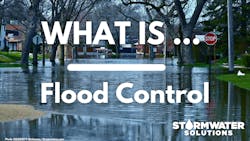With an increase in intensity and frequency of storms, the country has also seen an increase in the need for flood control measures.
In short, flood control is “the process of reducing the effects that flooding has on towns, villages, and other municipalities by hard or soft engineering methods,” according to ACI Corporation.
When speaking about flood control, a few other terms are often thrown around too, including flood mitigation and flood resilience.
According to the National Conference of State Legislatures, flood mitigation tactics can fall into two categories – structural and nonstructural. Structural forms, which include seawalls, floodgates, and levees, mitigate floods by reconstructing landscapes. Nonstructural tactics, which include elevated structures, zoning, and building codes, mitigate damage by removing people and properties away from risky areas.
Flood resilience, according to the U.S. Environmental Protection Agency, “refers to the ability of water and wastewater utilities to withstand a flooding event, minimize damage and rapidly recover from disruptions to service.” According to EPA, other mitigation measures include emergency response plans, barriers around key assets, elevated electrical equipment and more.
What is used for flood control?
In a guide for water and wastewater utilities, EPA provides examples of practical mitigation measures. To prevent intrusion of flood waters, the agency recommends the following:
- Implement a program to keep all drains and culverts clear of debris to
- Use sandbags to make a quick and low-cost barrier to minor flooding.
- Install backflow preventers on low-lying overflow pipes
To protect assets, EPA recommends:
- Secure and or elevate tanks to prevent them from floating away, releasing contents or damaging other equipment.
- Move vehicles to high ground and develop alternative methods to access the facility if entry is blocked by water or debris
- Elevate or relocate instrumentation, electrical controls, computers and records.
- Fill finished water storage tanks to full capacity
- Maintain sufficient supplies of chemicals and fuel in anticipation of supply disruptions during a flood.
What is the difference between flood control and floodplain management?
>Let’s explore floodplains. According to Federal Emergency Management Agency (FEMA), “Natural floodplains provide flood risk reduction benefits by slowing runoff and storing flood water. They also provide other benefits of considerable economic, social, and environmental value that are often overlooked when local land-use decisions are made.” Some floodplain benefits, include:
- Fish and wildlife habitat protection
- Natural flood and erosion control
- Surface water quality maintenance
- Groundwater recharge
- Biological productivity
- Higher quality recreational opportunities (fishing, bird watching, boating, etc.)
Additionally, floodplains provide excess water storage, slow the flow rate and reduce erosion, slow runoff and help manage flow regulation during non-flood periods.
According to FEMA, floodplain management is “a community-based effort to prevent or reduce the risk of flooding, resulting in a more resilient community.”
FEMA has minimum floodplain management standards for communities participating in the National Flood Insurance Program (NFIP), which is a collection of floodplain management regulations, policies, technical bulletins, and guidance you can navigate by keyword.
Real world examples of flood control
In February 2023, Pew Trusts published an article highlighting four states that took measures to make their land and populations more flood resilient.
For example, in Maine, communities received $5.4 million to support local climate action, which includes flood resilience planning, through the Community Resilience Partnership. Over in North Carolina, Governor Roy Cooper signed Executive Order 266, which calls for flood-resilient construction of state-owned buildings. This order builds on the state’s 2020 North Carolina Climate Risk Assessment and Resilience Plan and encourages state agencies to “to develop a process to avoid construction of schools, hospitals, and other facilities in current or projected areas with high flood risk.”
According to NBC News and the National Oceanic and Atmospheric Administration (NOAA), extreme weather caused $165 billion in damages in 2022. It was the third-costliest year on record and included three hurricanes and major flooding in Kentucky and Missouri. Hurricanes Fiona, Ian and Nicole brought $1 billion alone in damages.
In March 2023, the National Weather Service released its 2023 National Hydrologic Assessment.
“This spring season, approximately 146 million people are at risk for flooding in their communities, with nearly 6.4 million at risk for moderate flooding and 1.4 million at risk for major flooding,” the assessment said.
As these risks increase, innovations in flood control become more necessary. As more states, especially those in coastal areas, spring into action to implement flood resiliency measures, flood control will continue to be a trending topic for the industry.
About the Author
Katie Johns
Editor-in-Chief
Katie Johns, editor-in-chief of Stormwater Solutions, graduated from the University of Missouri in 2016 with a Bachelor of Journalism and a Bachelor of Arts in Spanish. Johns joined the Stormwater Solutions team in September 2019. Johns also helps plan the annual StormCon conference and co-hosts the Talking Under Water podcast. Prior to entering the B2B industry, she worked as a newspaper reporter and editor in Sarasota, Florida, and a magazine assistant editor in the Chicago suburbs. She can be reached at [email protected].



